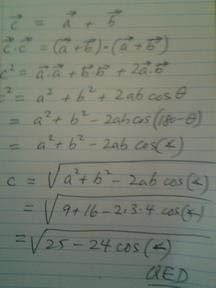To: piytar
Nope. 24.
I could look it up but the proof is trivial. Vector representing side c is vector of side a + vector of side b. Therefore, their dot products are equal, and when you expand that it's c = sqrt(a^2 + b^2 - 2abcos(angle))
192 posted on
06/29/2013 9:55:33 PM PDT by
FredZarguna
(Separated by a common language.)
To: FredZarguna
You’re a hoot! All that sophisticated dithering and equational BS and you *still* don’t have an answer (because you’ve decided you don’t know the angle).
Dude! It’s a JOKE! And clearly a 3-4-5 right triangle. :-)
Hold a sheet of paper up to it if you’re not sure. That’s what Thomas Edison would do.
I’m glad I’m not paying you to do anything for me. I’d go broke.
Are you a lawyer? Or a politician?
196 posted on
06/29/2013 10:06:58 PM PDT by
Nervous Tick
(Without GOD, men get what they deserve.)
To: FredZarguna; piytar
For the skeptic:

Also, note that 24 does not work for the extreme cases. When angle = 90, the resultant is 5 (Pythagoras.) But when the angle is 0, the answer must be 4-3=1 (it is, sqrt(25-24).) Finally, when the angle is 180, the length of the side must be 4+3=7. The only way you can get there is sqrt(25-24cos(180)) = sqrt(25+24) = sqrt(49) = 7.
198 posted on
06/29/2013 10:09:30 PM PDT by
FredZarguna
(Separated by a common language.)
To: FredZarguna
215 posted on
06/29/2013 10:49:22 PM PDT by
piytar
(The predator-class is furious that their prey are shooting back.)
FreeRepublic.com is powered by software copyright 2000-2008 John Robinson
